The blog of The Huntington Library, Art Museum, and Botanical Gardens.
“Something Waited For”
Posted on Thu., May 29, 2014 by
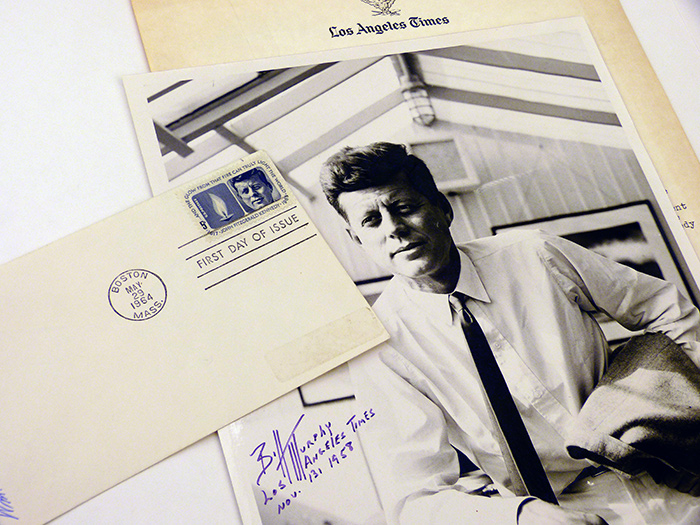
A commemorative JFK stamp issued on May 29, 1964, was based on a 1958 photograph taken in Santa Monica by William S. Murphy of the Los Angeles Times.
Fifty years ago today the U.S. Postal Service issued a commemorative stamp on what would have been John F. Kennedy’s 47th birthday. It features a pair of images: on the left is the eternal flame at Kennedy’s gravesite at Arlington National Cemetery, and on the right is a youthful portrait of the 35th president. Along the upper edge of the rectangular five-cent stamp is a line from Kennedy’s inaugural address: “And the glow from that fire can truly light the world.”
The thumbnail portrait of Kennedy is detailed from a photograph taken in November 1958 by Los Angeles Times photographer William S. Murphy when the then-senator was in Santa Monica at the home of his sister Patricia Kennedy Lawford and her husband, actor Peter Lawford.
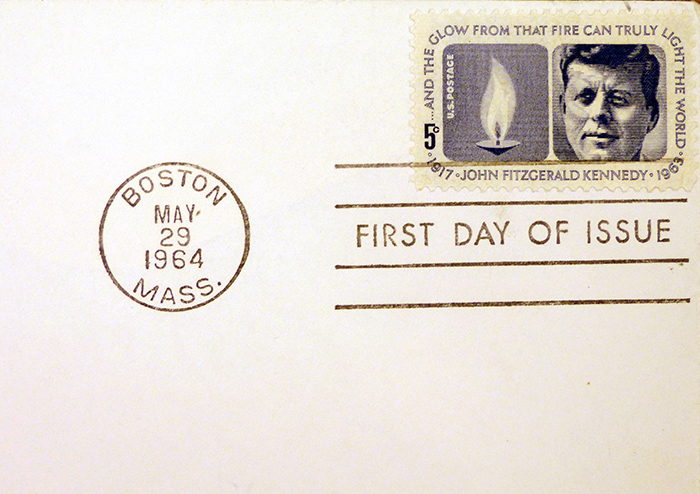
A first-day-of-issue of the JFK commemorative stamp.
“I made several pictures of him in the rumpus room of the house which had a glass skylight,” recalled Murphy in a 1977 letter to Paul Johnston, a collector who had asked Murphy to sign a photo for him. “On this particular exposure, I did not use a flashbulb, as we were just beginning to experiment with available light photography—something we do all the time now with 35 mm equipment. It was this photo that Jackie Kennedy selected from hundreds for the stamp.”
Murphy had a sense of the moment. “I…remember what I told my wife when I arrived at home that evening,” he wrote. “I told her that I had photographed the future President of the United States.”
Los Angeles Times staff writer Bob Pool recalled the episode in an article on Nov. 22, 2013, the 50th anniversary of Kennedy’s death. He quoted from the Murphy letter and mentioned that the signed photo (along with the letter and a canceled stamp) was for sale at a bookstore in Illinois. The Huntington’s Alan Jutzi, Avery Chief Curator of Rare Books, read Pool’s article and contacted the bookstore. He made an offer, and the signed photograph is now part of The Huntington’s collection.
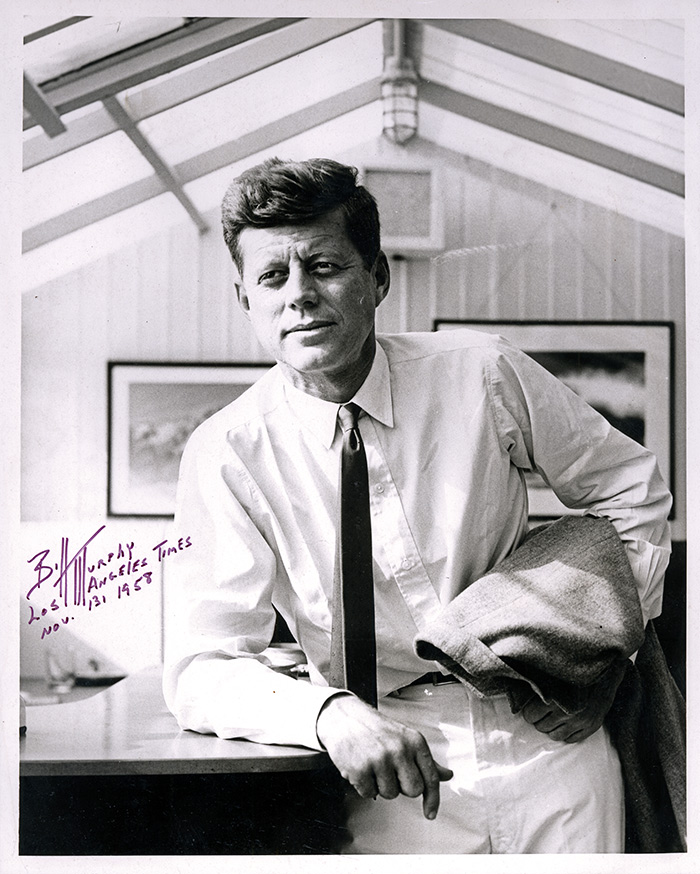
After spending the afternoon with Kennedy in November 1958, Murphy told his wife that he “had photographed the future President of the United States.” Photo by William S. Murphy, Los Angeles Times, 1958. Signed copy from The Huntington Library, Art Collections, and Botanical Gardens.
The Huntington doesn’t actively collect material on 20th-century American politics, but it does have extensive holdings on local and state history. It is also rich in materials related to the history of the Los Angeles Times, including the 780-box strong Times company archive. In recent years The Huntington has exhibited items from the papers of Times columnists Jack Smith and Al Martinez. More recently The Huntington acquired the papers of Charles Hillinger, who had a 46-year career with the paper. In Murphy’s picture, Kennedy is looking at Hillinger, one of the reporters in the room that day.
Less than two years after Murphy snapped this picture, the junior senator would be back in Los Angeles to accept the Democratic nomination for president by delivering his “New Frontier” speech at the Los Angeles Memorial Coliseum.
It’s fitting that an L.A. Times article about Murphy would lead to a remarkable acquisition. In 1983, Murphy himself had penned an L.A. Times story that led to what Jutzi calls one of the most remarkable Huntington acquisitions in his four-decade career as curator.
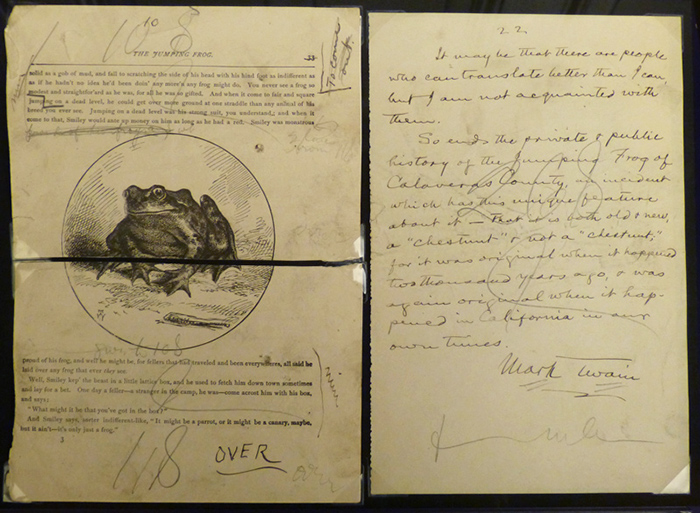
A 1983 newspaper article by Murphy led to another notable Huntington acquisition—a manuscript collection that included Mark Twain’s handwritten “Private History of the ‘Jumping Frog’ Story,” currently on display in “Remarkable Works, Remarkable Times: Highlights from the Huntington Library.”
Murphy was supplementing his photography duties with short articles for the View section of the paper. He reviewed “The Fabulous Frontier: Emigrants’ Guides to the West,” a small Huntington show featuring travel diaries from the 19th century. A Times reader in Santa Barbara wrote to Jutzi in the days that followed and said that his family owned the personal archive of Lloyd Stephens Bryce, editor of the North American Review from 1889 to 1896. In his papers were hand-written manuscripts and letters by Henry Ward Beecher, Charles Dickens, and Mark Twain, including an essay titled “Private History of the ‘Jumping Frog’ Story,” a colorful—albeit fictional—account of the making of Twain’s famed short story “The Celebrated Jumping Frog of Calaveras County.” Jutzi would eventually purchase a large portion of the collection; the Twain manuscript is among the 150 treasures on display today in “Remarkable Works, Remarkable Times: Highlights from the Huntington Library.”
“Bill was not only a fine journalistic photographer but a writer and local historian who regularly studied at The Huntington,” said Jutzi. “His interest in the Western American Overland experience would lead to the stunning Bryce archive.”
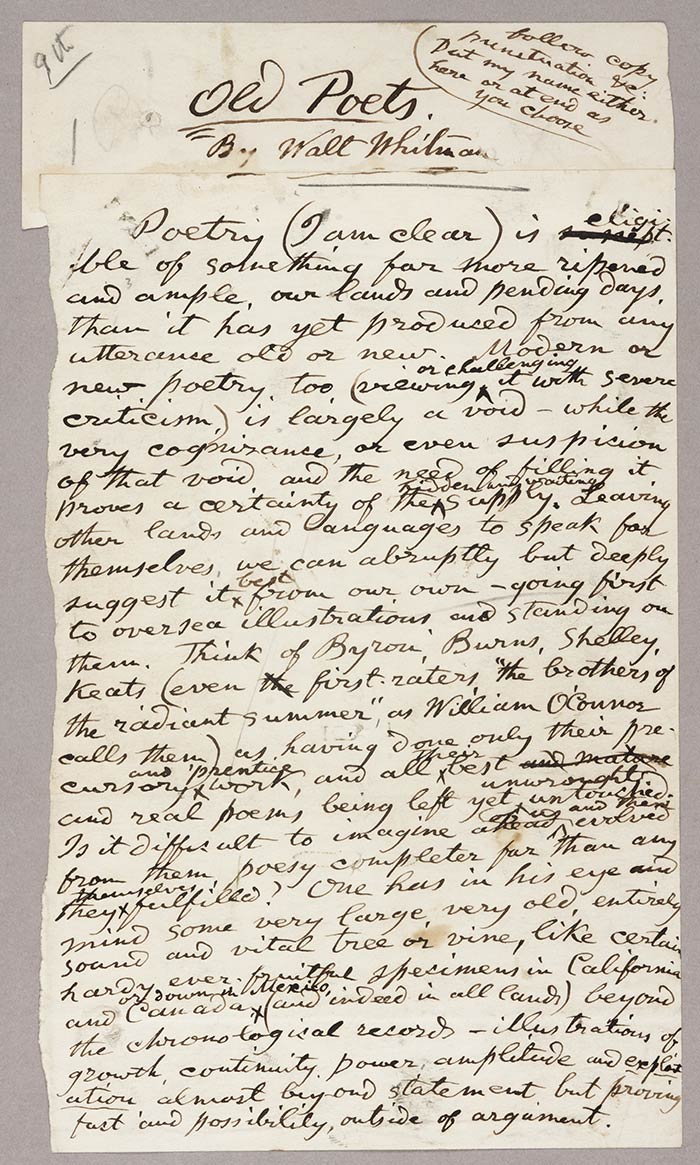
Also from the Bryce archive is one of Walt Whitman’s last published works, an essay titled “Old Poets.” It appeared in the North American Reviewin November 1890; Whitman died on March 26, 1892.
Other gems in the collection included a letter by Aaron Burr, articles by Civil War generals P. G. T. Beauregard and William Tecumseh Sherman, and an essay titled “Old Poets,” by Walt Whitman.
“Grand as to-day’s accumulative fund of poetry is,” pondered Whitman in that essay from 1890, reflecting on the state of the American canon at the end of the 19th century, “there is certainly something unborn, not yet come forth, different from anything now formulated in any verse, or contributed by the past in any land—something waited for, craved, hitherto non-expressed. What it will be, and how, no one knows.”
Matt Stevens is editor of Verso and Huntington Frontiers magazine.